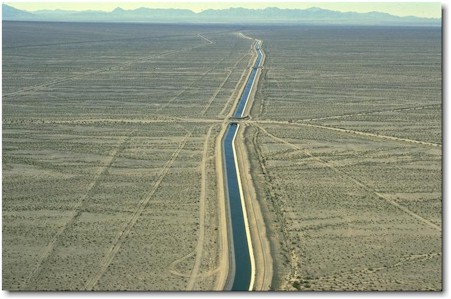With the implementation of the Quantification Settlement Agreement in 2003, the amount of Colorado River water available to the Metropolitan Water District of Southern California has been less than the capacity of the Colorado River Aqueduct (“CRA”). For example, the Bureau of Reclamation currently forecasts that Metropolitan’s use of Colorado River water will be 861,616 AF in 2015 http://www.usbr.gov/lc/region/g4000/hourly/forecast15.pdf. This is 438,834 AF less than the historical maximum annual amount of 1.3 million AF of Colorado River water conveyed through the CRA.
Hydrowonk had the opportunity to consider the availability of CRA wheeling capacity recently when Cadiz Inc. requested that Stratecon (Hydrowonk’s firm) evaluate the probability that the Colorado River Aqueduct will have space available to convey water for beneficial use by the Santa Margarita Water District and others within the Metropolitan Water District of Southern California (“Metropolitan”) over the 50 year initial term of the Cadiz Project.
The analysis is a forecast of the future availability of CRA wheeling capacity using reasonable assumptions based on available information. No forecast is certain. There is variability in critical underlying conditions. The forecast of available CRA wheeling capacity is no exception. Key variable factors include the variability in California agricultural water demands and hydrology:
- Metropolitan’s underwriting the risk of Priority 1, 2 and 3b agricultural users of Colorado River water exceeding 420,000 acre-feet (“AF”) per year;
- Availability of unused Colorado River water from agricultural users of Colorado River Water;
- Availability of surplus Colorado River water in the Lower Colorado River Basin
Fortunately, these risks can be quantified. Therefore, one may think in “probabilistic terms”, not absolute statements. That is, identify the statistical frequency of available wheeling capacity in terms of the likelihood and amount.
These questions are addressed within the complexities regarding the use of the CRA. The CRA is used to convey:
- Colorado River water available under Metropolitan’s Priority 4 entitlement subject to reductions for the amount the consumptive use of Colorado River water by Miscellaneous Present Perfected Rights and Indians exceed 14,500 AF;
- Long-term water transfers involving the Imperial Irrigation District (“IID”) with both Metropolitan and the San Diego County Water Authority (“San Diego”) and water conserved from the lining of the All American Canal and the Coachella Canal;
- Water Metropolitan receives water from the Lower Colorado Water Supply Project;
- Water available under Metropolitan’s land fallowing agreement with the Palo Verde Irrigation District (“PVID”). Under that agreement’s terms, the amount of water available varies annually;
- Metropolitan underwrites the risk of Priority 1, 2 and 3b annual use of Colorado River water fluctuating above or below 420,000 AF;
- Unused agricultural use of Colorado River water under Priority 3;
- Creation and recovery of Intentionally Created Surplus (“ICS”) Credits;
- An interstate storage agreement with Nevada; and
- Surplus Colorado River water for the Lower Colorado River Basin.
The availability of wheeling capacity for the Cadiz Project is assessed with a CRA Monte Carlo simulation model developed by Stratecon. The model generates time profiles of available capacity on the CRA in the face of trends in CRA uses and the statistical variability in:
- Metropolitan’s land fallowing program with PVID;
- overruns and underruns by Priority 1, 2, and 3b;
- underruns by Priority 3,
- the variability in the creation and recovery of ICS credits by Metropolitan in the face of the variability in State Water Project allocations;
- the uncertainty about the timing of recovery of stored water by Nevada; and
- the likelihood of shortages, normal years, domestic surpluses and flood control releases in the Lower Colorado River Basin.
For purposes of this analysis and as a conservative assumption, available capacity is defined as seventy percent of the difference between 1.25 million AF and all CRA uses. The Monte Carlo Study generates 10,000 iterations that represent random draws from defined statistical distributions for the variable factors.
After taking into account the variability and complexity of uses of Metropolitan’s CRA, Hydrowonk concludes that any concern about the availability of CRA wheeling capacity for the Cadiz Project is misplaced (see chart). This is not a material risk. Over the entire term of a 50-year agreement, there may only be unavailable wheeling capacity in a couple of years.
However, the Cadiz Project’s operational flexibility to engage in make-up deliveries enables the project’s cumulative deliveries to reach 2.5 million AF over the 50-year term of the project agreement.
There is no material risk that the initial term of the agreement must be extended so that cumulative project deliveries reach 2.5 million AF.
For a copy of the study, please visit Stratecon’s website, http://www.stratwater.com/stratecon-inc-report-concludes-capacity-in-the-colorado-river-aqueduct-for-conveying-cadiz-project-water-is-readily-and-reliably-available/



